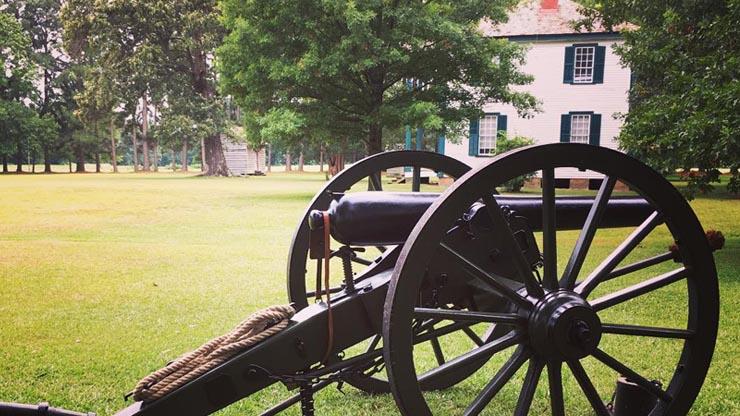When it comes to dynamic duos, BGES has one that ranks with the all-time greats: Bert Dunkerly and Wade Sokolosky. On March 25–28, 2020, the pair will team up to host “To the Bitter End: North Carolina in 1865,” a four-day tour detailing the fierce fighting from Averasboro to Bentonville that took place as the western and eastern theaters converged in the Tarheel State. Dunkerly is a historian, award-winning author, and speaker who is actively involved in historic preservation and research. Sokolosky is a 25-year veteran of the U.S. Army and a leading expert on the 1865 Carolinas Campaign. They spoke to the BGES Blog about their upcoming tour.


BGES Blog: When did your interest in the Civil War begin?
WS: Growing up in North Carolina exposed me at an early age to our state’s rich Civil War history. I was born and raised in Beaufort, North Carolina, where Union Gen. Ambrose Burnsides briefly located his headquarters during his 1862 expedition along the coast. Interestingly, my mother had an ancestor, a Confederate artilleryman, captured during that period at Fort Macon. However, it was not until my assignment at Fort Campbell, Kentucky, that my passion for studying the war took off. I blame this sudden interest to learn more on a fellow officer from Illinois, whose ancestor happened to have served in Sherman’s army. I honestly grew weary of the tales of “Uncle Billy’s Boys,” and sought to learn more. Three decades later, I am still researching, writing, and leading tours about Sherman.
BD: I have always been interested in both Colonial and Civil War history. I grew up not far from Gettysburg, and my grandparents lived in western Pennsylvania near French & Indian War sites. So I love both periods equally. My parents indulged me and we visited historic sites regularly when I was young.
BGES Blog: “To the Bitter End” will take BGES members on a fascinating tour of North Carolina in March 1865. What’s the historical significance?
WS: During a brief period in March 1865, Sherman’s army group fought four battles in North Carolina. These unexpected fights shocked Sherman’s veterans, who supposedly thought their enemy was done. I call this period of Civil War history in North Carolina “Two Weeks of Fury.” We will get the opportunity to explore two of these battles, Averasboro and Bentonville.
BD: This program covers the final phase of the war in North Carolina, which has some fascinating stories and amazing twists and turns. There are also some very pristine sites. Obviously Appomattox overshadows what happened here, but these events are equally as important. Unlike the Army of Northern Virginia, the Army of Tennessee had a line of retreat open. It had more men, and it could have fought on. Johnston’s decision to surrender allowed the fighting to end in all of the eastern seaboard states below Virginia.

BGES Blog: What’s your favorite part of the tour?
WS: Both Averasboro and Bentonville battlefields are fortunate in that they have escaped urban development throughout the past 155 years. Additionally, thanks to preservation efforts in recent times, large portions of the battlefields are protected for future generations to enjoy. The preservation work at Bentonville is something to be proud of as a student of the Civil War. The Bentonville Battlefield encompasses approximately 6,000 acres. In 1986, only 225 acres of that amount was preserved. Now, in 2020, roughly half of the battlefield is protected, almost 2,500 acres. On the tour, we get to explore the defensive works constructed by the soldiers.
BD: The battles of Averasboro and Bentonville are fascinating—and under appreciated. Wade is an expert on them, and it will be a treat to tour those sites with him. I find the maneuvering and events after those engagements very interesting: Johnston keeps his army intact and out of reach of Sherman’s forces. Then he hears rumors of Lee’s surrender. He is told by Davis to keep fighting but does not. Chaos erupts in the army’s camps. It’s not a neat ending as Appomattox was: There was a great deal of confusion and chaos. We’ll delve into those details.

BGES Blog: What do you enjoy about hosting a tour like “To the Bitter End”?
WS: First, making new friends with individuals that share my interest in our nation’s history. For this tour in particular, I love the reaction of folks seeing the four plantation homes that still stand watch over the battlefields. Each one has its own fascinating story.
BD: There is nothing more powerful, and rewarding, than being on the actual ground where events happened. It allows us to connect to our ancestors and understand their decisions and challenges. I also enjoy the camaraderie and engagement that are customary on BGES programs: We’ll debate, discuss, and probe, and all learn from each other.
BGES Blog: What’s it like hosting a tour as a duo?
WD: I think Bert and I complement each other well, and it makes for a perfect team. He is extremely knowledgeable of the events that occurred in the weeks that followed the Battle of Bentonville. Bert’s work on the Confederate Army of Tennessee’s final days is the standard. When I have a question, I reach for his book on my library shelf. With that in mind, I see my role in getting the armies through the campaign’s final battles setting the stage for Bert to share his expertise in closing out the war in North Carolina.
BD: Wade is a local expert and I’m excited to work with him. We divided up the tour based on our respective areas of expertise, with him leading the battle tours and me covering the subsequent retreat and surrender negotiations.
You must be logged in to post a comment.